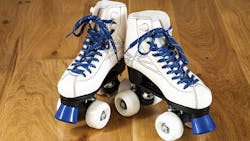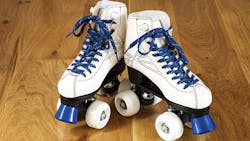Groups of kids skating as part of birthday parties filled the floor, clusters of wobbly bodies circling the rink. But in between those groups, there were glimpses of the telltale white of the skating aids – PVC contraptions used to help shaky skaters find their balance.
The 7-year-old with whom I went skating was new to the wheeled-shoe game. Once he mustered up the courage to try skating, he took to the floor. On his own.
He refused to hold anyone’s hand or to use a skating aid. He wanted to master this by himself.
While part of it I’m sure was determination to conquer this new challenge, another equal but unspoken part was social pressure.
Because safety isn’t cool.
From the way his eyes darted around the room, silently assessing the abilities of the other kids his age, I could tell that my 7-year-old friend was cognizant of his peers and didn’t want to embarrass himself.
To him, it was better to fall than to be seen as childish for holding an adult’s hand or using a safety device.
We’re friends here, so I feel like I can disclose something. I fell on the treadmill at the gym Saturday. It was not my proudest moment.
Mid run, I took a sip from my water bottle, which ended up leaking onto the belt. I slipped and fell on the water, and ended up clinging to the machine, desperately trying to reach the emergency stop string.
I didn’t have the emergency stop clip hooked to my shirt because no one ever falls on a treadmill, right?
When I first started running at the gym a few years ago, I immediately clipped the safety device on. Until I realized no one else did. Not wanting to be seen as a novice, I too started running untethered.
It turns out, what really isn’t cool is having four massive bruises all over my legs and repeatedly needing to painfully apply medicated bandages.
The skating adventure turned out well for my friend’s son. He became more confident and left the rink excited to go skating again.
But he, like me, took a calculated risk.
In his case, the skating aid was a backup option for new skaters and he knew a fall at his speed and height was unlikely to do much damage. In mine, I openly ignored a designed safety function and paid the consequences, brought to my knees by my now-wounded pride.
Safety may not be cool, but it definitely protects us from pain and injury. And I’d much rather being sitting at my desk free of pain every time I move my legs than worrying about being the beginner at the gym who uses the safety clip.
Now, that would be cool.
About the Author
Ginger Christ Blog
Associate Editor
Ginger Christ is an associate editor for EHS Today, a Penton publication.
She has covered business news for the past seven years, working at daily and weekly newspapers and magazines in Ohio, including the Dayton Business Journal and Crain’s Cleveland Business.
Most recently, she covered transportation and leadership for IndustryWeek, a sister publication to EHS Today.
She holds a bachelor of arts in English and in Film Studies from the University of Pittsburgh.

